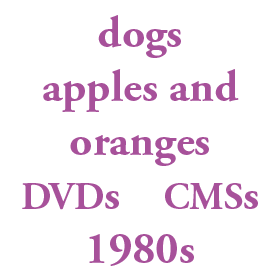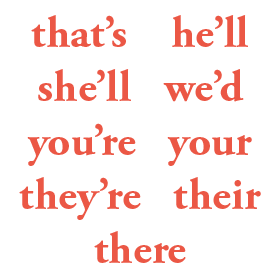4 Simple Things to Remember about Apostrophes
Apostrophes can seem like trivial, petty little things, and hardly worth the trouble they cause! But they are quite important. Using them well can make your writing a lot clearer, and using them poorly is a really bad look.
So take a few moments to make sure you’ve got a handle on apostrophes. At the end, I have a simple test for you.
1. Ownership

A major use of apostrophes is to indicate possession, or ownership. For example, the bone of the dog is the dog’s bone. If we leave out the apostrophe in dog’s bone, we have dogs, indicating the plural—that is, many dogs—which will cause momentary confusion for the reader.
Exceptions
There are some important exceptions to watch out for. Tradition dictates that these possessives don’t have an apostrophe: hers, its, yours, ours, theirs, his.
These are known as possessive pronouns. You just have to remember that they don’t have an apostrophe! (See below for more on its vs it’s.)
Dealing with words ending in s
What if it’s the dog of James? James already ends in s. The answer depends on how you prefer to say it aloud. Either of these is fine: James’ dog or James’s dog.
Ownership and plurals
The dog’s bone means the bone of the dog—that is, just of one dog. What about the bone of the dogs? Dogs already has an s at the end. The answer is simple: just place the apostrophe after the s: the dogs’ bone.
Watch out for some plurals. The plural of company is companies. So we get the company’s website (that is, the website of the company), but the companies’ websites (or the websites of the companies).
Family names can be tricky. The Jones family can be referred to as the Joneses. In that case, you’d refer to the Joneses’ dog, with the apostrophe at the end.
Also be careful with words like men, women and children. Because these are already plural, you just add ’s as usual. For example, the men’s team played the women’s team.
2. Apostrophes with Plurals

When you have more than one dog, you have dogs. Simple: you just add an s to the word.
Unfortunately, there can be a temptation to add an apostrophe to plurals even when ownership isn’t involved. This is a huge mistake, and is traditionally called the greengrocer’s apostrophe, as it’s very common to see signs for apple’s and orange’s outside fruit shops. O dear!
Making exceptions to avoid confusion
Occasionally, an apostrophe is used with plurals to avoid confusion. For example, the phrase mind your p’s and q’s would be confusing without apostrophes.
Be careful, though. There’s nothing confusing about referring to CDs, DVDs, CMSs and the like, so don’t use apostrophes there (as in CD’s). And there’s no need for an apostrophe in something like the 1990s.
3. Missing Letters

In English, we often contract words. For example, instead of saying that is nice, we say that’s nice. The i of is gets dropped, and the s joins with that.
You may argue that it’s no big deal to leave out an apostrophe here, because there’s no apostrophe in spoken English. But there are two reasons to get this right. Firstly, you look silly if you can’t do something as simple as this. Secondly, leaving it out can lead to confusion.
For example, it’s common to reduce he will to he’ll. Leaving out the apostrophe here would be hell. Likewise, instead of she’ll, we’d end up with shell. And we’d would be wed, we’ll would be well, we’re would read as were, and so on.
Even though we don’t use an apostrophe in spoken English, we pronounce he’ll differently from hell, so it’s important to differentiate them in writing.
It’s vs Its
Perhaps the most common and embarrassing punctuation error is the confusion between it’s and its.
It’s is a contraction of it is (or it has). So a simple way to determine whether or not its requires an apostrophe is to see it if makes sense as it is.
For example, it’s a nice day makes sense as it is a nice day. Thus, the apostrophe is required.
However, the dog chewed its bone can’t be changed to the dog chewed it is bone. Thus, an apostrophe is not appropriate here.
As we saw above, its is a possessive pronoun, and traditionally doesn’t have an apostrophe—just like hers, theirs and so on. If the possessive form of its did have an apostrophe, it would get confused with it’s (it is).
By the way, if you’re wondering when it’s appropriate to use its’, the answer is never!
Other words that get confused
Other words get badly confused when apostrophes are left out.
You’re (short for you are) is often confused with your. This is really just a straight out spelling mistake, but it arises partly from not thinking about what’s being expressed.
Likewise, they’re (short for they are) is confused with their (meaning of them) and there (indicating location).
And don’t confuse who’s (short for who is) with whose (meaning of whom).
4. Apostrophes with Verbs
Verbs are action words, like run, sit and walk. When used with he, she and it, we add an s: he runs, she sits, it walks.
A common mistake is to add an apostrophe, thus producing run’s, sit’s, walk’s. There’s never a time when this is appropriate, and such usage really should be a capital crime.
Test Yourself
OK, here’s a chance to test yourself. Which of these examples uses correct punctuation? (Answers are provided below.)
- It’s OK to ask questions.
- Most dog’s possess a tail.
- Marys’ blog is better.
- Dont be so sure.
- Well, we’ll see.
- You’re going to regret this.
- She cut off their tail’s with a carving knife.
- She was the people’s advocate.
- The car lost its hubcap.
- The bosses’ employees went on strike.
- DVDs are are a bit old now.
- A woman played in the mens’ team.
- The Web began in the early 1990’s.
- She clearly walk’s the walk.
- Mr Apple’s oranges are very sweet.
- He was in his 40s when he got married.
- Christmas celebrates Jesus’ birth.
- It’s hard keeping up with the Joneses.
So, how did you go? Do the explanations in this article make sense? If you have any questions, please raise them in the comments.
Here are the correct examples from the list above:
